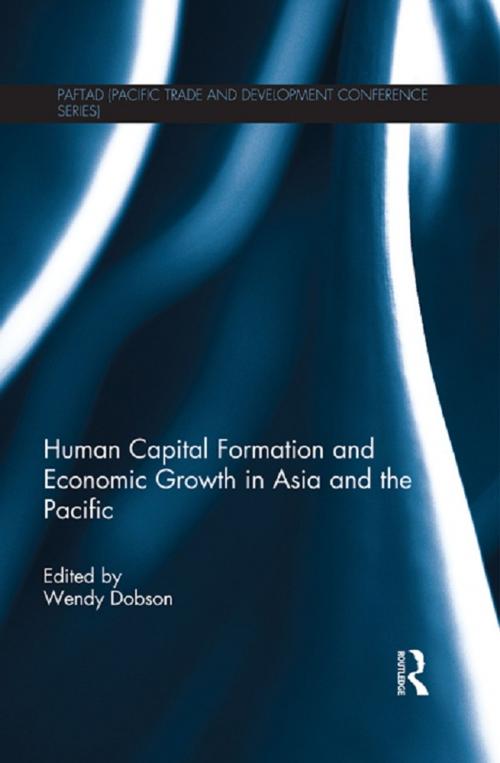Human Capital Formation and Economic Growth in Asia and the Pacific
Business & Finance, Economics, Comparative Economics, Nonfiction, Social & Cultural Studies, Social Science, Cultural Studies, Ethnic Studies| Author: | ISBN: | 9781135039820 | |
| Publisher: | Taylor and Francis | Publication: | July 18, 2013 |
| Imprint: | Routledge | Language: | English |
| Author: | |
| ISBN: | 9781135039820 |
| Publisher: | Taylor and Francis |
| Publication: | July 18, 2013 |
| Imprint: | Routledge |
| Language: | English |
The entire planet looks to Asian and other emerging markets to sustain growth momentum as traditional markets in the USA and Europe struggle with the slow and arduous processes of deleveraging after the global financial crisis. At the same time, there is growing recognition in Asia that the sources of growth must shift to sustain their own growth momentum in the years ahead. Heavy reliance on the region’s high savings rates and plentiful supplies of low-cost labour will have to shift towards increasing the human capital embodied in more educated and skilled labour forces capable of contributing to productivity growth and innovation as future drivers of growth.
Human Capital Formation and Economic Growth in Asia and the Pacific focuses on why and how countries are making this shift. The demographic transition is shown to be a significant factor as ageing populations in Japan, South Korea and China manage declining growth in the labour force by stepping up investments in education, and by changing policies and institutions. Lessons to be learned from these experiences by more youthful populations in Southeast Asia are explored. In addition, attention is paid to the consequences of cross-border differentials in technical knowledge and the quantity and quality of human capital. Several implications for public policy and for international cooperation on human-capital issues in the Asian region are identified.
The chapters in this volume are edited versions of papers presented at the 35th Pacific Trade and Development conference held in Vancouver, Canada, in June 2012. The conference goal was to better understand how governments and business in Asia and the Pacific can apply the key insight that one of the reasons economies grow is because of human-capital formation – the quality and diversity of the labour force are augmented – not just because the labour force grows in size. Students of Asia’s growth prospects will find several aspects of this volume of particular value. It includes chapters on the big-picture conceptual and measurement issues; on country experiences in meeting the imperatives of the demographic transition and investing in education and skills training; and on country experiences with attracting foreign knowledge and the supply and recruitment of skills across borders in Asia and the Pacific. Policymakers will also find useful the discussions of policy implications and the menu of issues requiring intergovernmental cooperation within the Asian region.
The entire planet looks to Asian and other emerging markets to sustain growth momentum as traditional markets in the USA and Europe struggle with the slow and arduous processes of deleveraging after the global financial crisis. At the same time, there is growing recognition in Asia that the sources of growth must shift to sustain their own growth momentum in the years ahead. Heavy reliance on the region’s high savings rates and plentiful supplies of low-cost labour will have to shift towards increasing the human capital embodied in more educated and skilled labour forces capable of contributing to productivity growth and innovation as future drivers of growth.
Human Capital Formation and Economic Growth in Asia and the Pacific focuses on why and how countries are making this shift. The demographic transition is shown to be a significant factor as ageing populations in Japan, South Korea and China manage declining growth in the labour force by stepping up investments in education, and by changing policies and institutions. Lessons to be learned from these experiences by more youthful populations in Southeast Asia are explored. In addition, attention is paid to the consequences of cross-border differentials in technical knowledge and the quantity and quality of human capital. Several implications for public policy and for international cooperation on human-capital issues in the Asian region are identified.
The chapters in this volume are edited versions of papers presented at the 35th Pacific Trade and Development conference held in Vancouver, Canada, in June 2012. The conference goal was to better understand how governments and business in Asia and the Pacific can apply the key insight that one of the reasons economies grow is because of human-capital formation – the quality and diversity of the labour force are augmented – not just because the labour force grows in size. Students of Asia’s growth prospects will find several aspects of this volume of particular value. It includes chapters on the big-picture conceptual and measurement issues; on country experiences in meeting the imperatives of the demographic transition and investing in education and skills training; and on country experiences with attracting foreign knowledge and the supply and recruitment of skills across borders in Asia and the Pacific. Policymakers will also find useful the discussions of policy implications and the menu of issues requiring intergovernmental cooperation within the Asian region.















